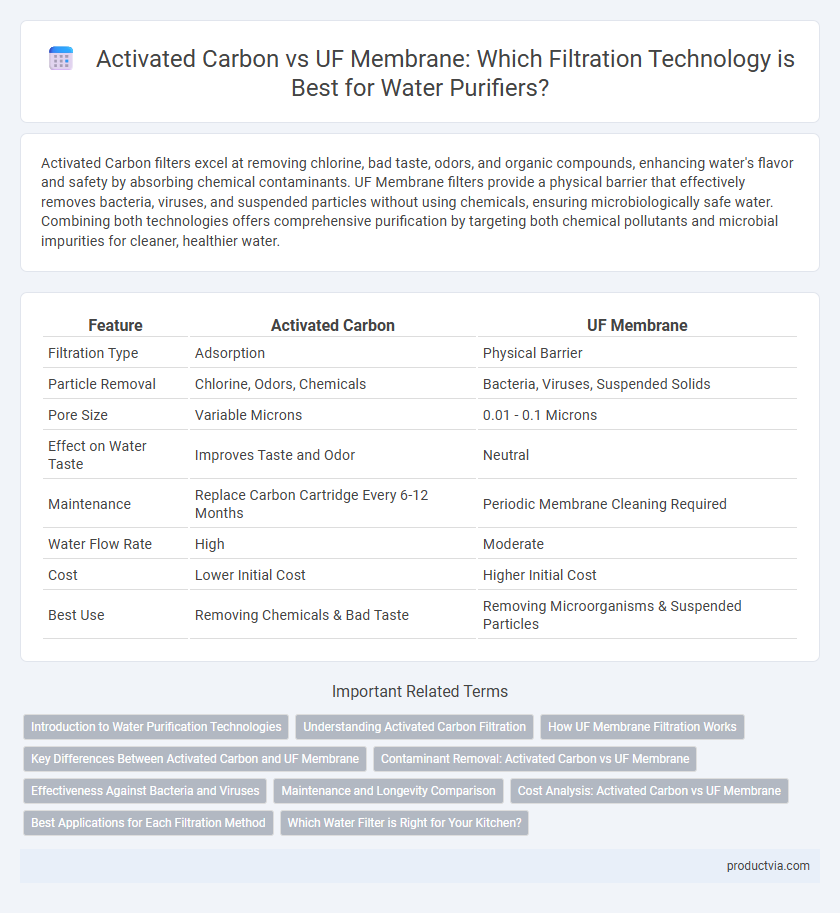Activated Carbon filters excel at removing chlorine, bad taste, odors, and organic compounds, enhancing water's flavor and safety by absorbing chemical contaminants. UF Membrane filters provide a physical barrier that effectively removes bacteria, viruses, and suspended particles without using chemicals, ensuring microbiologically safe water. Combining both technologies offers comprehensive purification by targeting both chemical pollutants and microbial impurities for cleaner, healthier water.
Table of Comparison
| Feature | Activated Carbon | UF Membrane |
|---|---|---|
| Filtration Type | Adsorption | Physical Barrier |
| Particle Removal | Chlorine, Odors, Chemicals | Bacteria, Viruses, Suspended Solids |
| Pore Size | Variable Microns | 0.01 - 0.1 Microns |
| Effect on Water Taste | Improves Taste and Odor | Neutral |
| Maintenance | Replace Carbon Cartridge Every 6-12 Months | Periodic Membrane Cleaning Required |
| Water Flow Rate | High | Moderate |
| Cost | Lower Initial Cost | Higher Initial Cost |
| Best Use | Removing Chemicals & Bad Taste | Removing Microorganisms & Suspended Particles |
Introduction to Water Purification Technologies
Activated carbon filters excel in removing chlorine, volatile organic compounds (VOCs), and bad odors from water by adsorbing contaminants onto their porous surface. Ultrafiltration (UF) membranes provide physical barriers that block bacteria, viruses, and suspended solids with pore sizes typically between 0.01 and 0.1 microns, ensuring microbiological safety. Combining activated carbon with UF membranes offers comprehensive water purification by addressing both chemical impurities and microbial contaminants for safer, cleaner drinking water.
Understanding Activated Carbon Filtration
Activated carbon filtration effectively removes chlorine, volatile organic compounds (VOCs), and bad odors from water through adsorption, improving taste and safety. This porous material traps contaminants on its large surface area without removing beneficial minerals. Activated carbon filters are ideal for eliminating chemical impurities but do not filter out pathogens like bacteria or viruses, requiring complementary technologies for complete purification.
How UF Membrane Filtration Works
UF membrane filtration uses a hollow fiber membrane with pore sizes ranging from 0.01 to 0.1 microns to physically block contaminants such as bacteria, viruses, and suspended solids from water. This process relies on pressure-driven filtration, where water passes through the membrane's microscopic pores, allowing only clean water molecules to flow through while retaining impurities. Compared to activated carbon, which adsorbs organic compounds and chlorine, UF membranes provide a more comprehensive barrier against microbial and particulate pollutants, ensuring safer drinking water.
Key Differences Between Activated Carbon and UF Membrane
Activated carbon filters use porous carbon to adsorb impurities like chlorine, volatile organic compounds, and bad odors, improving taste and removing chemicals from water. UF (Ultrafiltration) membranes physically block particles, bacteria, and viruses larger than 0.01 microns, providing a microbial barrier without removing dissolved salts. Key differences include activated carbon's chemical adsorption capabilities versus UF membrane's mechanical filtration, with activated carbon enhancing taste and UF membranes ensuring microbial safety.
Contaminant Removal: Activated Carbon vs UF Membrane
Activated carbon excels at removing chlorine, volatile organic compounds (VOCs), and unpleasant odors through adsorption, making it effective against chemical contaminants. Ultrafiltration (UF) membranes provide a physical barrier that blocks bacteria, viruses, and suspended solids, offering superior removal of microbial pathogens. Combining activated carbon with UF membranes can enhance overall water purification by targeting a broader spectrum of contaminants.
Effectiveness Against Bacteria and Viruses
Activated carbon primarily excels at removing chlorine, odors, and organic compounds but has limited effectiveness against bacteria and viruses. Ultrafiltration (UF) membranes provide a physical barrier that removes bacteria, viruses, and other pathogens with pore sizes typically between 0.01 to 0.1 microns. For reliable microbial contamination control, UF membranes outperform activated carbon in ensuring safer drinking water.
Maintenance and Longevity Comparison
Activated Carbon filters require regular replacement every 3 to 6 months due to saturation with contaminants, impacting maintenance frequency and cost. UF Membranes typically last 1 to 3 years with periodic backwashing, offering lower maintenance intensity and better longevity under proper usage. The choice between activated carbon and UF membranes depends on balancing frequent media replacement against longer membrane life for efficient water filtration.
Cost Analysis: Activated Carbon vs UF Membrane
Activated carbon filters typically offer a lower initial cost compared to UF membranes while effectively removing chlorine, odors, and organic compounds from water. UF membranes, though more expensive upfront, provide superior filtration by removing bacteria, viruses, and suspended solids, leading to potentially lower health-related costs over time. Considering long-term maintenance and replacement frequency, activated carbon filters may incur higher costs due to frequent cartridge changes, whereas UF membranes generally have a longer lifespan and reduced operational expenses.
Best Applications for Each Filtration Method
Activated carbon filters effectively remove chlorine, volatile organic compounds (VOCs), and odors, making them ideal for improving taste and reducing chemical contaminants in municipal tap water. UF (ultrafiltration) membranes excel at removing bacteria, viruses, and suspended solids, making them suitable for filtering biological contaminants in water sources such as well water and rainwater. Combining activated carbon with UF membranes provides comprehensive purification by targeting both chemical impurities and microbial pathogens.
Which Water Filter is Right for Your Kitchen?
Activated carbon filters effectively remove chlorine, volatile organic compounds (VOCs), and odors, enhancing taste and safety, making them ideal for households prioritizing chemical removal. UF membrane filters offer superior bacterial and particulate removal without requiring electricity, suitable for areas with biological contamination or unclear water sources. Selecting the right water filter depends on your water quality concerns: activated carbon excels in chemical purification, while UF membranes provide robust microbial protection.
Activated Carbon vs UF Membrane for filtration Infographic

 productvia.com
productvia.com